On January 13, 1991, crack Soviet troops moved into Vilnius, the capital of Lithuania, to stop the independence movement in its tracks. Lithuania's "singing revolution" had revived the songs, the flag, the traditions, the language, and the Catholic faith that had been put down by the Communist rulers. Moscow seemed to think that a fast and brutal show of force would restore the status quo, or at least slow down the independence movement.
Quite the opposite happened, of course. The troops met a determined, but unarmed, populace. Thousands of Lithuanians had surrounded the parliament and the national TV tower. The troops took the tower, killing 14 unarmed civilians in the process. While they achieved their immediate goal, gaining control of Lithuanian television, they suffered an enormous moral defeat and united the people as never before. Even in Moscow, a massive solidarity rally for the Lithuanians took place.
The following May, the ministry of foreign affairs invited a Fellowship of Reconciliation team of nonviolence trainers to Lithuania to hold workshops as part of the government's efforts to develop a nonviolent national defense. We saw a video of the January 13 killings and talked with many of the people who had been at the TV tower that night. One of the persons we talked to was Vladas Viloziunas, renowned artist and sculptor.
He told us, "The Communist Party and the KGB were well organized and planned each step in their attack. But they failed to calculate the spiritual energy we had. God loves these paradoxes! I came home that evening as the people sang before the troops, and the psalm I read for the day spoke of the wheels of the chariots being stopped in the field. I'll remember that all my life."
AFTER A WORKSHOP at the national parliament building, we went out to the cemetery where the 14 martyrs of January 13 are buried. Every grave was covered with flowers. The families of several of the victims were there, lighting candles, praying, planting flowers.
In back of the graves was a traditional, hand-carved wooden crucifix, typical of a country rich in religious folk art. Carved by Ipolitas Uzkurnys, this crucifix was atypical in one sense: looking at the right hand of Jesus, I saw that his fingers were raised in a "V," the sign of victory!
I've thought of that wooden crucifix many times, but especially after the coup attempt failed last August in Moscow. In its aftermath, the Baltic states, including Lithuania, were given their independence. Out of the suffering and pain, victory had come. As the hymn puts it, "Truth forever on the scaffold, wrong forever on the throne. But beyond the dim unknown, standeth God within the shadows keeping watch above his own."
Richard L. Deats was a United Methodist minister and director of interfaith activities for the U.S. Fellowship of Reconciliation who had visited the Soviet Union 14 times and had trained nonviolent activists in countries around the world when this article appeared.

Got something to say about what you're reading? We value your feedback!
